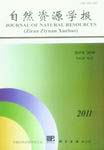Resources Utilization and Management
YANG Zi-sheng, HAN Hua-li, ZHU Yu-bi, ZHAO Qiao-gui
In present study on land use/land cover change (LUCC), rationality analysis and evaluation of land use change has not been taken seriously. In particular, there is hardly any study on the theory and method system for evaluating rationality of land use change. By taking Luxi City as an example, which is located in the middle and low mountainous basin and valley area in southwest Yunnan, this paper has discussed the concept and connotation of rational degree of land use change and constructed the evaluation target, estimation method, and grading standard system for studying rational degree of land use change. Then, based on these, it has quantitatively analyzed and evaluated the rational degree of the change in every land use type and rational degree of the overall land use change driven by the nearly-eight-year Program of Converting Farmland to Forest in Luxi City. It aims to provide basic foundation for promoting the sustainable use of land resources in mountainous areas and scientific implementation of the Program of Converting Farmland to Forest.The evaluation results reveal the following facts: 1) During recent eight years, the whole city witnessed land use type changes in a total area of 77602.80 hm2. Rational degree (RD value) of the change was only 48.98% while the irrational degree (ID value) was 51.02%, making the change at the "moderately rational" level. 2) Among all land use types, farmland, forest and waste grassland had the largest changes. Farmland was mainly changed into forest, garden plot and waste grassland, a result driven by the Program of Converting Farmland to Forest. During recent eight years, the whole city had 19661.07 hm2 of farmland converted to ecological uses. Of which, 18886.09 hm2 were the farmland suitable for cultivation (farmland that "should not have been converted") and only 774.98 hm2 were the farmland not suitable for cultivation (farmland that "should be converted"). The nearly-eight-year Program of Converting Farmland to Forest (grassland) had a rational degree of only 3.94%, but an irrational degree of 96.06%. This means that the project is "highly irrational". 3) Waste grassland was changed mainly into forest, which was caused largely by the forestation efforts in waste hills and closed mountains to match the "conversion of farmland". 4) Forest was mainly changed into farmland. Such change had a rational degree (RD value) of only 44.62% and an irrational degree (ID value) of 55.38%, making it "moderately irrational". 5) By and large, the land use change in Luxi City during recent eight years driven by the Program of Converting Farmland to Forest had some rational elements. For example, some farmlands on steep slopes were converted to ecological uses, forestation. However, the general land use change showed extremely obvious irrationality, which was demonstrated by the following facts. About 96% of the converted farmlands were the farmland suitable for cultivation that "should not have been converted. " Some 5595.54 hm2 of good-quality flat field, flat dry land, terraced field and terraced land were converted, accounting for 28.46% of the total converting amount. In addition, when the Program of Converting Farmland to Forest was implemented, large scale deforestation for farmland was carried out (amounting to 12634.25 hm2). Of the deforested land, over 3/4 is on steep slopes of over 25° or becomes farmland on slopes of below 25° without any soil and water conservation measures. These outstanding problems made the land use change of Luxi City during recent eight years have an extremely low rationality degree.
